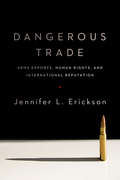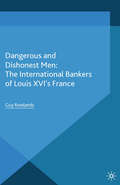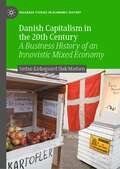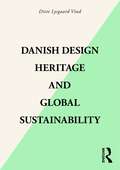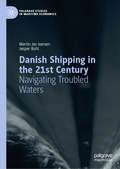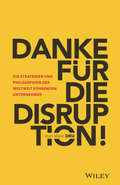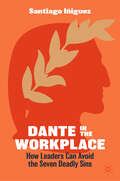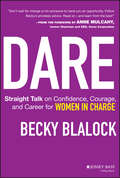- Table View
- List View
Dangerous Trade
by Jennifer EricksonIn 2013, the United Nations approved the Arms Trade Treaty (ATT), which sets legally binding standards to regulate global arms exports. This groundbreaking treaty reflects a growing concern that small and major conventional arms play a significant role in perpetuating human rights violations, conflict, and societal instability worldwide. While many countries once staunchly opposed shared export controls and their perceived threat to political and economic autonomy, they are now beginning to embrace numerous agreements, such as the ATT and the EU Code of Conduct.Jennifer L. Erickson explores the reasons top arms-exporting democracies have put aside past sovereignty, security, and economic worries in favor of humanitarian arms transfer controls, and she follows the early effects of this about-face on export practice. She begins with a brief history of failed modern arms-export control initiatives and then tracks arms transfer trends over time. Pinpointing the normative shifts in the 1990s that put humanitarian arms control on the table, she reveals that these states committed to these policies out of concern for their international reputations. She also highlights how arms-trade scandals threaten domestic reputations and thus help improve compliance. Using statistical data and interviews conducted in France, Germany, Belgium, the United Kingdom, and the United States, Erickson challenges existing IR theories of state behavior, while providing insight into the role of reputation as a social mechanism and the importance of government transparency and accountability in generating compliance with new norms and rules.
Dangerous Trade: Arms Exports, Human Rights, and International Reputation
by Jennifer EricksonThe United Nations's groundbreaking Arms Trade Treaty (ATT), which went into effect in 2014, sets legally binding standards to regulate global arms exports and reflects the growing concerns toward the significant role that small and major conventional arms play in perpetuating human rights violations, conflict, and societal instability worldwide. Many countries that once staunchly opposed shared export controls and their perceived threat to political and economic autonomy are now beginning to embrace numerous agreements, such as the ATT and the EU Code of Conduct. Jennifer L. Erickson explores the reasons top arms-exporting democracies have put aside past sovereignty, security, and economic worries in favor of humanitarian arms transfer controls, and she follows the early effects of this about-face on export practice. She begins with a brief history of failed arms export control initiatives and then tracks arms transfer trends over time. Pinpointing the normative shifts in the 1990s that put humanitarian arms control on the table, she reveals that these states committed to these policies out of concern for their international reputations. She also highlights how arms trade scandals threaten domestic reputations and thus help improve compliance. Using statistical data and interviews conducted in France, Germany, Belgium, the United Kingdom, and the United States, Erickson challenges existing IR theories of state behavior while providing insight into the role of reputation as a social mechanism and the importance of government transparency and accountability in generating compliance with new norms and rules.
Dangerous and Dishonest Men: The International Bankers Of Louis Xiv's France (Palgrave Studies in the History of Finance)
by G. RowlandsAt the start of the eighteenth century Louis XIV needed to remit huge sums of money abroad to support his armies during the War of the Spanish Succession. This book explains how international bankers moved French money across Europe, and how the foreign exchange system was so overloaded by the demands of war that a massive banking crash resulted.
Daniel Dobbins Distillery, Inc.
by William J. Bruns Jr.A distiller increases whiskey production and income declines because of accounting methods in use. Questions are raised regarding the treatment of expenditures which can be classified as production, inventory, or period costs. The necessary aging process raises added questions about prior period restatements and needed financing. A rewritten version of an earlier case by R.F. Vancil and R.H. Deming.
Danielle Marcoux at AdNet2Win Technologies
by Anthony J. Mayo Joshua D. MargolisDanielle Marcoux, Director of Web Design at AdNet2Win Technologies, must decide how best to confront Charles Davide, the Chief Technology Officer and leader of the design team charged with overseeing a major upgrade of the company's proprietary customer loyalty platform. Davide has kept tight control on the development process and has not allowed the design team to discuss difficult issues or challenge each other. Marcoux decides she must confront Davide about his management approach before the team loses their commitment to the design effort.
Daniels and Fisher: Denver's Best Place to Shop
by Mark BarnhouseFor 129 years, Daniels and Fisher and May-D&F proudly served the Mile High City. Today, the restored Daniels and Fisher Tower adorns the Sixteenth Street Mall while the I.M. Pei-designed ice-skating rink and hyperbolic paraboloid at May-D&F survive only in memories. The story of these institutions is filled with fascinating characters, including dashing, tower-building William Cooke Daniels; his aristocratic English wife, Cicely; and flamboyant William Zeckendorf, whose city-building dreams outpaced his finances. Generations of Denverites shopped these stores and still remember white-gloved sales ladies, meals served in the D&F Tea Room and views from the observation deck. Join author Mark A. Barnhouse as he brings the spectacular Christmas displays, fantastic fortnights celebrating foreign cultures and Carl Sandell--the seven-foot, five-inch Daniels and Fisher doorman--back to life.
Danish Capitalism in the 20th Century: A Business History of an Innovistic Mixed Economy (Palgrave Studies in Economic History)
by Stefan Kirkegaard Sløk-MadsenThis book outlines the origins of Danish Capitalism and prosperity, from a poor and devastated minor state in the 19th century to a consolidated universal mixed economy welfare state at the end of the 20th century. The book argues that firm-based innovation drove Danish prosperity and redistributive capacity. It is a comprehensive but manageable examination of the institutions and choices that shaped a highly innovative and wealthy nation. The book relies on history and economic theory, presents commonly accepted narratives and theories, and contributes new explanations. Therefore, the book also traces both antecedents and the current state of 20th-century capitalism in Denmark and particular outcomes and critical institutions such as firm age, the labor market, and pension schemes. The book will be of interest to academics in business history and economic policy, as well as policymakers and all those interested in mixed economy studies.
Danish Crown: Feeding the Future
by Daniela Beyersdorfer David E. Bell Damien P. McLoughlin Mette Fuglsang HjortshoejDanish Crown, one of the world's largest exporters of pork meat and one of Europe's tops five producers of beef, faced increasing headwinds in 2021, making CEO Jais Valeur feel like the core of the meat business was under attack. As a cooperative and prominent player in Denmark's high-standard agriculture sector, the company had particular responsibilities and constraints including a high labor and production cost and strict regulatory environment. More recently growing concerns over climate change had led to increasing criticism of the environmental impacts of livestock production. Consumers in Denmark and worldwide were turning away from meat, for its climate impact but also for concerns about animal welfare and their own health. The case discusses these industry trends and describes Danish Crown's efforts to respond by transitioning to a more sustainable company, with several initiatives and investments underway to meet its ambitious carbon reduction targets. Valeur was convinced that sustainability leadership was the only way to keep its customers, add value to commodity parts of the business, and earn the "license" to keep operating in the future. However, the more the company publicized its efforts, the more it got under attack from environmental activists for alleged "greenwashing". Just like many of its peers, Danish Crown's management team needed to devise a strategy that would allow for its survival despite the growing adverse trends.
Danish Design Heritage and Global Sustainability
by Ditte Lysgaard VindWith a bias for action, this book offers valuable insights into the origins of the much-celebrated Danish design tradition and how it can be employed to create design solutions to address today’s environmental crisis using the planetary boundaries as positive creative constraints. Danish design has long been revered for its high-quality aesthetics, materials and craftmanship, encouraging sustainability without compromise. This book explores the lessons to be learnt from Scandinavian design ideals, introduces the philosophy and principles of circular economy and showcases the potential power of combining circular economy and design in helping to mitigate the effects of climate change. It presents a range of case study examples across multiple sectors and includes interviews with Danish designers from architecture, furniture, fashion, digital and industrial design, providing unique insights by some of the world’s leading contemporary designers. Bridging theory and real-world insights and experiences, this book builds on the framework of the 4Rs – The Circular Way: Reduce, Reuse, Recycle and Replace to encourage innovation through the replacement of environmentally damaging materials and business models. A must-read for product designers, industrial designers, consultants, business developers, sustainability professionals and students interested in learning how to design and implement circular, sustainable models into practice.
Danish Shipping in the 21st Century: Navigating Troubled Waters (Palgrave Studies in Maritime Economics)
by Martin Jes Iversen Jesper BuhlSpurred by global macro-economic shifts, commercial and financial turbulence, as well as technological leaps in the early years of the new millennium, the Danish shipping industry has changed dramatically since the turn of the century. This book provides a new understanding of how rapid business environmental changes frame strategic choices and industry structures. The authors combine a conceptual chapter with three selected business history cases to apply a methodical approach to their study. Together, the five chapters unveil patterns in the development of Danish shipping which are historical and, at the same time, consider questions that address the present situation and the challenges of our time. In other words, this short book uses history for the purpose of understanding the present and to develop thinking for the future.
Danke für die Disruption!: Die Strategien und Philosophien der weltweit führenden Unternehmer
by Jean-Marie DruSteve Jobs, Jeff Bezos, Larry Page, Sergey Brin, Zhang Ruimin, Marc Benioff - viele Worte wurden bereits über diese großen Unternehmer der Welt geschrieben. In diesem Buch geht es nicht darum, ihre Leistungen zu beschreiben. Es geht auch nicht um ihr Charisma, ihre persönlichen Prüfungen oder ihren Platz in der Populärkultur. Wir alle haben schon genug davon gehört oder gelesen. In diesem Buch geht es um den Unternehmer, den Denker. Es geht um die großen Ideen, die bahnbrechenden/disruptiven Gedanken, die innovativen Grundlagen und Geschäftsphilosophien, die zu ihren Erfolgen geführt haben. "Danke für die Disruption!" untersucht 20 der bedeutendsten Wirtschaftsführer unserer Zeit. Der Autor Jean-Marie Dru, selbst ein Disruptor, der den Begriff vor Jahrzehnten geprägt hat, erklärt nicht nur die Auswirkungen dieser Führungskräfte auf ihre eigenen Unternehmen, sondern auch ihren immensen Einfluss auf die gesamte Geschäftswelt. Jedes Kapitel ist vollgepackt mit detaillierten Analysen, aufschlussreichen Kommentaren und persönlichen Beobachtungen des Autors. Die disruptiven Ideen fallen in die Kategorien Führung, Innovation, soziale Verantwortung, Marke und Kultur. Für jedes dieser Themen erklärt der Autor 1) die wichtigsten innovativen Ideen, die dem Unternehmen Milliarden eingebracht haben; 2) wie ihre Innovationen und Ideen die Geschäftswelt im Allgemeinen beeinflusst haben; und 3) wie auch andere Manager und Führungskräfte diese disruptiven Ideen in ihren eigenen Organisationen umsetzen können. Dieses ansprechende Buch veranschaulicht, wie die Vision eines disruptiven Innovators weit über sein Unternehmen hinausgehen kann, und ermutigt und inspiriert die Leser, zu Disruptoren in ihrem eigenen Unternehmen zu werden. Das Buch ist ein Muss für jeden, der sich für das Warum und Wie hinter den bedeutendsten und einflussreichsten Unternehmensleistungen unserer Zeit interessiert.
Danone S.A.: Becoming a Mission-Driven Company (A)
by Benjamin C. Esty Emilie BillaudEmmanuel Faber became CEO of Danone SA, the French food and beverage company, in 2014. Right from the start, he ran the company with a dual commitment to both profit and purpose (i.e., ESG objectives). In fact, in 2018, he said, "It's time to make sustainable business the only way of doing business." The case examines his leadership and efforts to make Danone a more socially and environmentally responsible company, culminating with a shareholder vote in June 2020 to adopt a new legal status recently created under French corporate law called the "entreprise mission" (EAM or mission-driven company). Shareholders overwhelmingly approved the bylaw change which allowed Danone to redefine its "raison d' tre" (corporate purpose) to include social and environmental objectives. In response, Faber said, "You have toppled the statue of Milton Friedman here today," a reference to the author of the famous article entitled "The Social Responsibility of Business is to Increase Profits." As the first publicly traded company in France to adopt the new structure, all eyes were on Faber to see how he would run the company and achieve multiple corporate objectives.
Danone S.A.: Becoming a Mission-Driven Company (B)
by Benjamin C. Esty Emilie BillaudDescribes the events that took place in the first six months after Danone became France's first "entreprise mission" (mission-driven company).
Danone S.A.: Becoming a Mission-Driven Company (C)
by Benjamin C. Esty Emilie BillaudDescribes the events that took place in the first year after Danone became France's first "entreprise mission" (mission-driven company).
Danone: Changing the Food System
by Daniela Beyersdorfer David E. Bell Federica GabrieliEmmanuel Faber, Chairman and CEO of the food and beverage company Danone, believed that humankind had only ten years to bend the curve on climate change and restore the biodiversity that the global food and agricultural ecosystem was critically dependent on. Upon becoming CEO in 2014, he had built on Danone's long history of CSR-engagement to give a boost to the company's mission to bring health through food to as many people as possible. In September 2019, he reflected on the progress achieved thus far, including efforts to support regenerative agriculture through new contract types for famers in their milk division. Still, many questions remained in his journey to fix what he saw as the food industry's broken system: How could they manage the desired long-term transition to a sustainable system while also meeting the company's short-term financial targets? What was the role of the private sector? What economic model could support an inclusive transition? How to engage partners and consumers to embark on this journey?
Danshui Plant No. 2
by William J. Bruns Jr. Julie H. Hertenstein Kelvin LiuDanshui Plant No. 2 in southern China has a one-year contract with Apple Inc. to assemble 2.4 million iPhones. In the first three months of the contract, the plant is unable to assemble as many phones as expected and is operating at a loss. The plant manager must analyze the budget and prepare a summary of monthly operations to help identify the source of performance problems. The plant has had difficulty hiring enough workers despite raising wages over 30%. In addition, the assembly process for an iPhone is complicated, with 140 steps involving over 100 components. The plant manager considers whether a flexible budget would be more useful for uncovering problems than the static budget currently being used. Students must perform break-even and flexible budget analyses and calculate price and usage variances as they consider solutions for the plant's problems with the iPhone contract. This case, which explores the challenges of outsourcing manufacturing, can be used as an introduction to managerial accounting.
Dansk Designs Ltd.
by Charles B. Weigle John W. RosenblumDansk Designs Ltd., a supplier of high quality, highly designed tableware products, plans to enter a new product area in housewares. Past growth and anticipated future expansion make organizational changes necessary. Overseas operations, design changes, supplier relations, quality control, marketing strategy, and competition all have impact on the organizational structure.
Dansko, Inc.
by Amy C. Edmondson Victoria W. WinstonFor the past 18 months, Mandy Cabot had worried that the shoe business she had built into a thriving operation with $90 million in annual revenue and over 110 employees might instead be a "house of cards." The management philosophy that had guided Dansko's growth, "home schooling"--taking young energetic employees with little business experience and mentoring them--seemed ill-suited for the next phase of growth. Equally as precarious was the fact that with few exceptions, none of the senior management team had any prior experience in the footwear industry. So when a well-respected industry leader asked to talk about a merger, Cabot had to admit that with her "crisis of confidence," it might just be time.
Dante in the Workplace: How Leaders Can Avoid the Seven Deadly Sins
by Santiago IñiguezHow can leaders learn to embrace humility to foster collaboration? How can gratitude be cultivated to foster an environment of comradery? And how do leaders practice emotional intelligence in different situations to navigate conflicts and make rational decisions? Blending classical literature and philosophy, this latest book from Professor Santiago Iniguez draws inspiration from Dante Alighieri's "Purgatorio" to explore how leaders can cultivate management virtues to counter the vices that hinder organizational success. Taking readers on a captivating journey, this book contains real-world anecdotes from business situations to offer valuable insights for modern-day leaders. Beginning with an introduction to "Purgatorio", where the protagonist, guided by the poet Virgil -who in the book is featured as a Chatbot-, ascends the mountain of purgatory, overcoming various vices that symbolize the human condition. Each terrace of the mountain represents a specific vice, and as Dante confronts them, he purifies his soul to achieve the virtues needed to reach paradise. Drawing parallels from Dante's journey, the book delves into the realm of leadership and organizational management, where leaders are faced with their own set of vices in the form of workplace challenges. It explores: Pride vs. humility Envy vs. gratitude Wrath vs. patience Sloth vs. diligence Greed vs. generosity Gluttony and Lust vs. moderation With real-life anecdotes from different industries, showcasing how leaders encountered and effectively countered these vices through the cultivation of management virtues, the book offers a unique and valuable perspective on leadership, decision making and organizational dynamics.
Daoism and Environmental Philosophy: Nourishing Life (Routledge Explorations in Environmental Studies)
by Eric S. NelsonDaoism and Environmental Philosophy explores ethics and the philosophy of nature in the Daodejing, the Zhuangzi, and related texts to elucidate their potential significance in our contemporary environmental crisis. This book traces early Daoist depictions of practices of embodied emptying and forgetting and communicative strategies of undoing the fixations of words, things, and the embodied self. These are aspects of an ethics of embracing plainness and simplicity, nourishing the asymmetrically differentiated yet shared elemental body of life of the myriad things, and being responsively attuned in encountering and responding to things. These critical and transformative dimensions of early Daoism provide exemplary models and insights for cultivating a more expansive ecological ethos, environmental culture of nature, and progressive political ecology. This work will be of interest to students and scholars interested in philosophy, environmental ethics and philosophy, religious studies, and intellectual history.
Darby's Investment in Sirma: Professionalizing an Entrepreneurial Firm
by Suraj Srinivasan Eren KuzucuIn March 2010, Burak Dalg n (HBS MBA 2004) led private equity firm Darby's investment in S rma, a local Turkish water and beverage company. S rma was owned and managed by members of two Turkish business families. The existing management, while being highly entrepreneurial, had paid less attention to managing the company in a professional manner, leading to a highly leveraged balance sheet and a significant need for financing. After the investment, S rma introduced new products, opened a new factory, and built up its financial reporting system from scratch. Two years after Darby's investment, S rma's operational performance had improved. However, the company was still suffering from significant financial problems. By early 2013, although S rma had received two cash injections from Darby, the company still required another round of financing. Dalg n was looking at three potential options: Should Darby make another investment in S rma? If Darby stayed invested in S rma, should it replace its managing partners? If Dalg n advised Darby to exit, would that be a premature move?
Darby's Investment in Sirma: Professionalizing an Entrepreneurial Firm (A)
by Suraj Srinivasan Eren KuzucuIn March 2010, Burak Dalg n (HBS MBA 2004) led private equity firm Darby's investment in S rma, a local Turkish water and beverage company. S rma was owned and managed by members of two Turkish business families. The existing management, while being highly entrepreneurial, had paid less attention to managing the company in a professional manner, leading to a highly leveraged balance sheet and a significant need for financing. After the investment, S rma introduced new products, opened a new factory, and built up its financial reporting system from scratch. Two years after Darby's investment, S rma's operational performance had improved. However, the company was still suffering from significant financial problems. By early 2013, although S rma had received two cash injections from Darby, the company still required another round of financing. Dalg n was looking at three potential options: Should Darby make another investment in S rma? If Darby stayed invested in S rma, should it replace its managing partners? If Dalg n advised Darby to exit, would that be a premature move?
Darden Restaurants: The Nine Square Feet
by Joshua D. Margolis James BarnettIn June 2021, Darden Restaurants CEO Gene Lee contemplates how to position the world's biggest full-service restaurant more than one year into the COVID-19 pandemic.
Dare
by Becky BlalockFrom a veteran Fortune 500 executive, how women can reach and succeed in top leadership positionsThough women hold a majority of the managerial and professional jobs in the workforce, they occupy a mere 14% of C-suite positions at Fortune 500 firms. To break through this stubborn glass ceiling, women must learn to take bold steps when career-defining moments arise. During her 33-year career at Southern Company, a Fortune 500 utility company, Becky Blalock rose to become CIO in a traditionally male industry. Now she offers her own hard-won advice, as well as that of 28 top female executives, to show all aspiring women how to dare to reach the highest tier of leadership and C-suite positions. Includes advice and mentoring lessons from top women business leaders such as: Anna Maria Chávez, CEO of the Girl Scouts of the USA; Kat Cole, President of Cinnabon; Carol Tomé, CFO of Home Depot; Dr. Beverly Tatum, president of Spelman College, and Jeanette Horan, CIO of IBM, among many othersFeatures straightforward, honest advice on gaining confidence, speaking up, finding mentors, learning to fail, building a network of allies, managing others, and moreWritten by pioneering business leader Becky Blalock, with a Foreword by Anne Mulcahy, former chairperson and CEO of Xerox CorporationDare is must-needed guide for women everywhere, at every level, striving to develop the character, skills, and relationships that deliver greater success in the workplace.
Dare to Be Different: Beyond Benchmarking
by Jeffrey PfefferThis chapter suggests that great companies, and the most successful, are those that are able to see the inherent value in a business model that breaks the mold in their industry and have the courage to act on their insights about how to do things differently.
